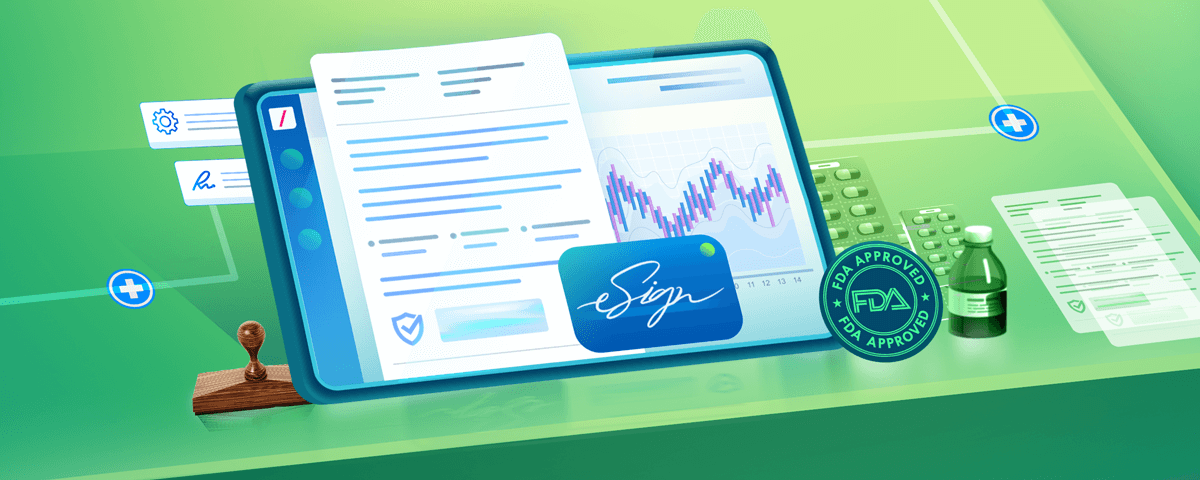All the efforts and pursuits of the US Food and Drug Administration are directed towards the advancements of public health nationwide. It exercises strong leadership to ensure we use good quality food and drugs.
The FDA formulates rules & regulations, carries out inspections, grants research permissions, and whatnot to protect the quality of drugs, biologics, and medical devices. To achieve all this, the organization and others (individuals, groups, or businesses who apply for research or who own a company that comes under the FDA) have to deal with tedious paper-based documentation processes and undergo the troubles of wet signatures. This takes a lot of time, money, and patience.
To help professionals focus on their goal rather than spending hours getting a signature on a form, most business and government entities accept and promote the use of electronic signatures today. FDA too has approved eSign usage under its regulations to lubricate the process.
FDA & eSign share the common goal of safety
FDA and electronic signatures are two different fields but both work for a common objective – safety.
Here’s how –
The Food and Drug Administration protects public health. Its sole purpose is to critically examine the efficacy and safety of various human and veterinary drugs, biological products, medical devices, etc. FDA also works with multiple industries to issue recalls and safety alerts for the nation’s health protection.
On the other hand, an electronic signature is based on a technology that guarantees the validity and legality of the signature. It protects individuals and businesses from frauds and forgeries and helps them carry out their professional work without impediments.
Checklist | How to ensure eSignature validity as per FDA CFR 21 Part 11?
Title 21 CFR Part 11 is a section of the Code of Federal Regulations of the FDA. It is responsible for establishing the regulations on electronic records and electronic signatures. More commonly known as Part 11, it sheds light on all the criteria under which electronic records and signatures are considered to be valid and at par with traditional paper records.
Today most manufacturing companies, individual researchers, and people, in general, have made a switch from paper-based processes to an electronic model of operations. Seeing this, a new set of regulations for electronic records and signatures have been subjected under the FDA CFR 21 Part 11.
Here is the checklist for an electronic record/signature to be accepted by the FDA –
Validation: For Security
It covers the following factors –
- Limited system access for the authorized signers
- Responsibility and accountability of the signers
- Data encryption within the system
Audit Trails: For Traceability
It covers the following factors –
- A complete and secure audit trail of the signing process
- Versions of the audit trail if something in the document gets altered
- Availability and accessibility of the audit trail by the FDA
- Type of information in the audit trail (signer details, date and time stamp, the purpose of signing, system details, etc.)
Electronic Signatures: For Valid Use
It covers the following factors –
- The uniqueness of every electronic signature
- Scope of reusing or reassigning a specific electronic signature to someone else
- Explicit association of every electronic signature with its electronic record so it cannot be altered by ordinary means
- Verification of the signer’s identity at the time of signing
Copies of Records: For Reference
It covers the following factors –
- A well-defined process to generate detailed hard copies of the electronic record
- Scope of inspecting, reviewing, and copying the record by the FDA
- Potential of the system to automate the export of the electronic record in various formats (PDF, XML, or SGML)
Record Retention: For Efficiency
It covers the following factors –
- Proper controls to check the uniqueness of all identification codes and passwords
- Periodic check of the expiry of identification codes and passwords’ validity
- Scope of getting back the code and password if the authorized person leaves the organization
- Scope of disabling a code and password in case somebody forgets/misplaces it
Here is the list of all the FDA forms for your ease. You can directly search for the one you are looking for or even put filters to access the relevant form.
Here’s why eSign is legal, valid, and reliable
- There are multiple laws supporting eSign – Government bodies worldwide realized the great potential of electronic signatures and formulated laws to give eSign equal importance as traditional wet signatures. Here are the laws that support eSign –
- ESIGN (The Electronic Signatures in Global and National Commerce) Act – The US government passed this act to make electronic signatures valid in a court of law.
- UETA (The Uniform Electronic Transactions Act) – Drafted by the Uniform Law Commission, this act puts forth a legal structure for eSign usage in the states of the US.
- eIDAS (electronic IDentification, Authentication, and Trust Services ) – It regulates electronic signatures and various electronic transactions in the European Union’s internal market.
- eSign has the means to identify the signing parties – You might be worried about identifying the signing parties in virtual signing ceremonies. But with good eSign service providers, you get highly professional attribution and authentication methods to capture the right signatures.
- Audit trails to record all the steps of signing – Tampering electronic records is quite easy today and therefore a concern for both individuals and businesses. But, with detailed audit trails, you can eliminate this risk as it consists of end-to-end details of the eSign transaction. It consists of information like the signer’s details, the IP address of the system, the date and time stamp of each activity, the geolocation of the signing ceremony, etc.
- Record retention with lifetime accessibility – A copy of all the signed documents is stored in secure cloud storage that can be retrieved whenever required.
- eSign improves document signing processes – What’s better than completing a tedious document signing process without moving out of your chair? eSign helps in doing the same. You just need to create or upload an existing document, add signature blocks, and send it for signatures. The receiver just needs to click to sign the document. This reduces errors, saves time, cost, and resources, and makes way for an uninterrupted signing process.
Jump on the eSign bandwagon with Revv
The best way to ensure compliance with the FDA CFR 21 Part 11 checklist is to start using Revv for electronic signatures. Revv comes with features that match the requirements of the FDA for an eSign to be valid and enforceable. Here is a detailed list –
- Multiple ways to eSign – You have the liberty to choose from three different signature types (click-to-sign, draw a signature, or click-to-initial) while sending documents for eSign.
- PDF upload and eSign – You can easily upload your PDF forms or documents in Revv, edit them using the drag-and-drop editor, and add signature blocks to them to send for eSign.
- Governance and Compliance – You need to be double sure of the compliance standards while dealing with government organizations like the FDA. Revv follows the regulations of all significant eSign-related laws. All the documents created and signed using Revv are legal and valid.
- Security – Revv’s high-security standards put an end to its customers’ insecurities. Along with email authentication, it offers One Time Password (OTP) based authentication to mitigate risks and fraudulent attempts.
- Audit trail & evidence summary certificate – Once the signing ceremony is completed, the sender of the document receives an evidence summary certificate that acts as proof of the transaction. There is even an audit trail with details like date and time stamps, signers’ details, and IP addresses.
- Activity tracking – You can keep a check of all the users’ activities in a document using this feature. You get access to a detailed log of information like who opened the email, who viewed the document, and who signed it.
- Record retention – You get cloud storage of all your electronic records saved in Revv. You can easily retrieve them whenever you want and get rid of the pain of finding paper documents in office shelves.
- Bulk send and eSign – Sending multiple documents at once with Revv by your side. You can draft and send multiple documents directly using a CSV.
| START YOUR ESIGNATURE JOURNEY WITH REVV The best document automation & eSignature platform! Sign up for Free No Risk, No Credit Card Required |
Move towards a smarter way to sign documents
We must change and evolve with time to explore and experience better versions of things in life. Better processes can help you achieve more and can make your life better. An electronic signature is one such example of evolution in the world of documents.
A simple switch to eSign from old and messy handwritten signatures can open the gates to a much more relaxed document signing process. eSign is simple, legal, and stress-free. Make the switch today and you won’t regret it ever.



